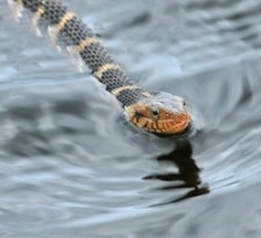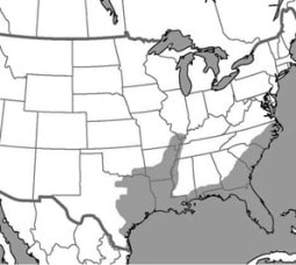Banded Water SnakeNerodia fasciata |

Custom Search
|
The banded water snake can be found across the Coastal Plain in North and South Carolina, Georgia and throughout Florida. It's range extends west across the southern Alabama and Mississippi, and into Louisiana, Arkansas and the southeast Oklahoma.
The species occurs as far north as Illinois and southeast Missouri. In a situation similar to that of some Florida invasive snake species, they were also introduced in California, where the species has since become established. They also hybridize with the Salt Marsh Snake where the 2 come in contact. The banded water snake can be found in nearly all freshwater habitats within its range, including lakes or ponds, streams, rivers, wetlands, swamps, canals, wet prairies and marshes. They are occasionally found in slightly brackish waters. In the southern regions of its massive range, they may be active all year-round, but otherwise, it becomes inactive during the cold winter months. In the colder weather, the banded water snake will take refuge in burrows or under piles of vegetation near water and hibernate, or more accurately brumate. The banded water snake is both a diurnal and nocturnal species, but during the summer intense heat, it becomes most active at night. If disturbed, their first reaction is fleeing and take refuge in water. But if cornered the banded watersnake may flatten its head and body to appear larger and perhaps trying to mimic other more dangerous venomous snakes. If the threat persists they will they will strike ferociously and repeatedly. It will also emit a foul-smelling musk if picked up or stepped on in an attempt to deter its attacker.

As implied by its name, these snakes are very strong swimmers, spending about 2/3 of its life in the water. They have been recorded remaining submerged for more than 20 minutes, now that's impressive.
These snakes measure from 24 to 42 inches (61 to 107 cm) in length, with a record size of 62.5 inches (159 cm) from a Florida specimen. The banded watersnake species displays sexual dimorphism. Females are typically heavier and longer than males although proportionally males do have longer tails. Females also grow faster than males. These are mid-sized, heavy-bodied semi-aquatic water snakes, with a variable ground color ranging from yellow-tan, gray, reddish, light brown to brown and even black. Darker crossbands cover the entire body usually, these tend to be wider on the back and slender along the sides. In older specimens, this contrasting pattern is sometimes so faint that they appear to be nearly uniform dark brown in color. Even within the same subspecies, there is extensive variation individual coloration. They have strongly keeled scales on the back. Their head is distinctly wider than the neck with round eyes, usually with a darker top and lighter color on the sides. There's an obvious dark stripe running from each eye to the corners of the mouth. They have a tan or yellow belly marked with black or dark brown, large triangular or rectangular shaped spots. Although somewhat similar the markings on the venomous copperhead (Agkistrodon contortrix), are shaped more like an hourglass. They are also known by other common names like Cope’s water snake, southern banded water snake, southeastern banded water snake, southern banded watersnake, broad-banded watersnake, banded watersnake, Florida banded water snake, Florida watersnake. Curiously queen snakes (Regina septemvittata) are also known as the banded water snakes but are totally unrelated to the "real" banded water snake (Nerodia fasciata). Taxonomy / Subspecies The species gets its specific scientific name from their characteristic crossbanding, "fasciata" derives from the Latin for "band". Some scientists consider the salt marsh snake (Nerodia clarkii) to be a subspecies of the banded watersnake (Nerodia fasciata). While other scientific sources have considered them to be a subspecies of the northern water snake (Nerodia sipedon). There are currently 3 recognized subspecies of banded water snakes which differ mainly in geographic distribution but also color and pattern. Banded watersnake (Nerodia fasciata fasciata - Linnaeus, 1766) - Found in the USA in east Texas, Louisiana, southeast Oklahoma, Arkansas, western Mississippi, southern Alabama, Florida, southern Georgia, South Carolina, North Carolina, southeast Missouri and Illinois. Broad-banded watersnake (Nerodia fasciata confluens - Blanchard, 1923) - Found in Oklahoma, Arkansas, Louisiana, Mississippi, Missouri and East Texas. Florida watersnake (Nerodia fasciata pictiventris - Cope, 1895) - The Florida banded water snake is found throughout Florida and southeastern Georgia. The species has also been introduced to Brownsville in Texas and has also established populations in California. Diet / Feeding These water snakes feed mainly on amphibians and fish, including minnows and pikes, eels and the occasional crayfish. Although throughout most of its range the other subspecies tend to eat mainly fish, the Florida water snake subspecies diet is made up mostly of frogs. These snakes are active foragers, they use their Jacobson's organ combined with the forked tongue to detect prey. By poking its head into aquatic vegetation or debris they flush prey from their hideout and quickly pursue, kill and swallow it whole. They are non-venomous but do have an anti-clotting compound in their saliva, if prey escapes it will leave a blood trail for the snake to follow. What's interesting and unusual is that frogs are consumed rear-first and fishes as usual in most snakes is eaten head-first. Reproduction Very little is known about the species reproduction, but in spring males have been observed engaging in courtship aggregations probably trying to mate with receptive females. It's believed that several males may try to mate with a single female at once. Both courtship season and hatchlings birth timing depends on geographic location and subspecies but they are typically thought to mate in the spring. These are viviparous snakes, giving birth to live young, that develop inside the female's body. Young snakes are usually born between July and October, although the Florida watersnake is believed to give birth between May and August. The clutch size varies anywhere from 9 up to 57 hatchlings, but generally an average of 20 to 25 per litter. The newborn snakes are about 8 to 9.5 inches (200–240 mm) in length. Conservation / Threats The banded watersnake is classified as Least Concern species on the IUCN Red List. There are no known major threats to the banded watersnake, and it's not currently considered to be at risk of extinction. But some local populations have been reduced or eliminated as a result of aquatic vegetation being removed or the drainage of wetlands. The species is still widespread and with a presumed large population, as a result, there are currently no conservation measures in place for these snakes. However. they are often killed by people out of fear, because of their similar appearance to the venomous cottonmouth (Agkistrodon piscivorus) with which they share habitat. Roadkill can also be considered somewhat of a threat to them.
|
Scientific Classification |
© 2014 Snake Facts About Us | Privacy Policy | Contact




